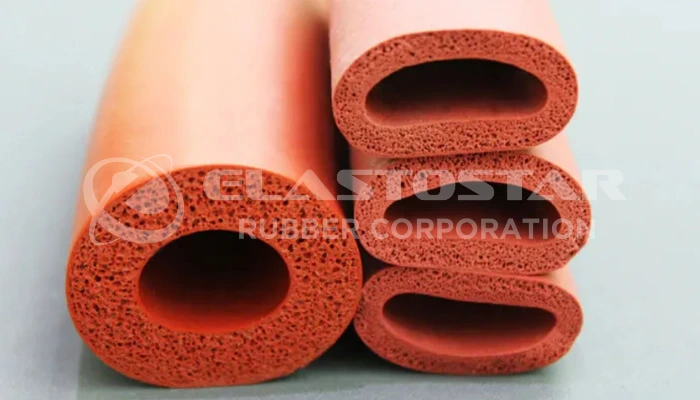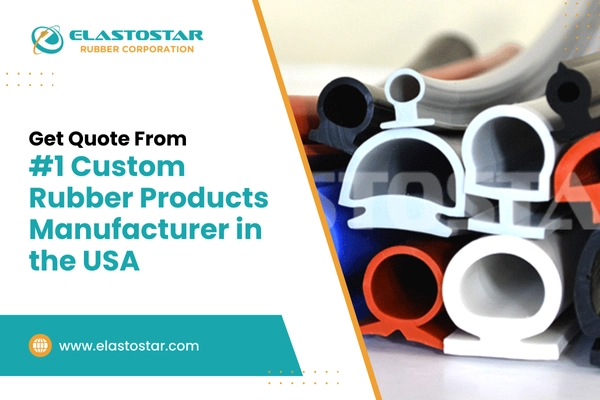Silicone rubber is critical in the aerospace industry because it can handle extreme conditions. Its resistance to high temperatures, pressure variations, and environmental exposure makes it ideal for sealing systems and gaskets used in aircraft. Known for its flexibility, durability, and chemical resistance, silicone sponge rubber helps modern aircraft’s safety, performance, and longevity.
In the blog, we explore its specific applications, advantages in aircraft design, comparisons with alternative materials, and its influence on the future of aerospace solutions.
Table of Contents
What are the properties of silicone rubber that are ideal for aerospace applications?

One key feature is its ability to handle a wide range of temperatures, from -75°F to +500°F. This makes it perfect for parts that must endure high heat, like aerospace seals used in engines and exhaust systems.
Additionally, silicone gaskets are known for their flexibility and ability to keep their shape even after long-term use. This is important for parts like aerospace gaskets, which must stay effective under pressure changes and mechanical stress.
Another benefit of silicone rubber is its chemical resistance. It doesn’t break down when exposed to fuels, lubricants, or hydraulic fluids, which is common in aviation seal components. This makes it a reliable choice for aircraft seals and hoses.
Compared to materials like EPDM or neoprene, silicone rubber performs better in terms of temperature resistance and chemical durability. While those other materials might be cheaper in some cases, they can’t handle the tough conditions that silicone rubber easily manages in aerospace applications.
Why Silicone Excels in Seal Aviation Applications?

Silicone seals are highly preferred for aviation because they perform well under extreme conditions. One main reason is their ability to maintain a strong and reliable seal despite significant temperature fluctuations.
Whether facing freezing temperatures at high altitudes or extreme heat near engine parts, silicone rubber remains stable and effective in ensuring a secure seal.
In addition to handling temperature changes, silicone rubber is resistant to environmental factors like UV exposure and ozone, which can often cause other materials to degrade or weaken over time. This makes aerospace rubber ideal for applications that require durability and longevity, ensuring that the material stays strong throughout the life of the aircraft.
Some specific examples of where airplane seal components made from silicone rubber are used include:
- Fuel tank seals must handle fuel exposure and constant temperature shifts.
- Door and window gaskets: Silicone window seals keep the cabin pressurized and block out external environmental elements while maintaining flexibility.
- Landing gear seals: These seals face tough conditions, handling everything from harsh weather exposure to pressure changes as the aircraft takes off and lands.
Read More- Top Applications of Silicone Rubber in the Aerospace Industry
Silicone Rubber’s High-Temperature Superiority in Aerospace Polymer Seals

Spongs gaskets are crucial in the aerospace industry, especially in areas exposed to extreme heat. They are commonly used in jet engines and exhaust systems, where seals and gaskets must endure high temperatures without losing effectiveness.
For example, aerospace polymer seals made from silicone rubber are designed to handle intense heat while maintaining a secure fit, ensuring the safety of critical components.
Another major application is in thermal insulation components, where silicone rubber helps protect parts of the aircraft from heat generated by engines or other systems. This thermal stability makes silicone rubber a reliable choice for engine gasket material that needs to perform consistently in high-temperature environments.
Compared to other materials, silicone rubber’s heat resistance, which can handle temperatures up to 500°F, ensures that it remains effective even under extreme conditions.
Whether used in aerodynamic seals or insulation, silicone rubber plays a vital role in maintaining the reliability and safety of aircraft systems.
Heat Resistance of Silicone Rubber vs. Other Elastomers in Aerospace Applications
| Material | Temperature Range | Heat Resistance | Common Aerospace Uses |
| Silicone Rubber | -75°F to +500°F | Excellent | Jet engines, exhaust systems, thermal insulation |
| EPDM | -60°F to +300°F | Good | Seals for electrical insulation and weatherproofing |
| Neoprene | -50°F to +275°F | Moderate | Fuel handling and oil resistance components |
How Does Silicone Rubber Support Lightweight Aircraft Design?
In aerospace, using lightweight materials is vital for improving fuel efficiency, enhancing performance, and reducing operational costs.
Sponge cord plays a key role in achieving these goals by offering a combination of lightness, strength, and durability.
It helps reduce the overall weight of aerospace parts while maintaining their functionality and safety, making it an excellent material choice for various applications in aircraft design.
- Lightweight nature
Silicone rubber is significantly lighter than many other materials, including EPDM rubber, making it ideal for reducing an aircraft’s overall weight. - Durability and strength
Despite its light weight, silicone rubber maintains its durability and strength, which is essential for tolerating extreme aerospace conditions. - Applications in hoses
Silicone rubber hoses are used in high-temperature fluid transfer systems. They offer heat resistance without adding extra weight, which is crucial for aviation companies. - Use in cables
It is commonly used in aircraft cables for insulation, contributing to weight reduction and effective performance in aircraft sealing applications.
By using silicone rubber, aerospace companies can achieve the necessary balance between reducing weight and ensuring the durability and reliability of essential aircraft components.
Silicone Rubber vs. Fluorosilicone in Aerospace
Silicone rubber and fluorosilicone are both valuable in aerospace, but their unique properties make them suitable for different purposes.
| Property | Silicone Rubber | Fluorosilicone |
| Temperature Range | -75°F to +500°F | -75°F to +400°F |
| Chemical Resistance | Good (not for fuels/oils) | Excellent (fuels/oils) |
| Ideal Uses | Engines, insulation | Fuel systems, hydraulics |
When to Use Each
- Silicone Rubber: Best for high-temperature applications like engine seals and thermal insulation.
- Fluorosilicone: Preferred for chemical resistance, fluorosilicone is especially used in fuel systems and hydraulic applications.
Meeting Aerospace Safety Standards with Silicone Rubber
Do you know that silicone rubber components used in aerospace must comply with strict FAA and military standards to guarantee safety and reliability?
These components undergo rigorous testing for temperature resistance, pressure variations, and chemical exposure. They must also pass fire-resistant seal tests to prevent fire risks and ensure stability, even in extreme conditions during flight.
For military applications, silicone rubber must meet MIL-SPEC certifications, including mechanical strength tests, compression set resistance, and chemical compatibility.
These standards ensure that silicone rubber can handle harsh environments, such as extreme weather, high altitudes, and exposure to corrosive chemicals, making it reliable for both commercial and military aircraft.
Custom Silicone Rubber Solutions for Aerospace
We provide custom silicone rubber solutions for the aerospace industry, meeting the highest safety, durability, and performance standards. As a custom rubber product manufacturer, we offer reverse engineering, design help, and the shortest lead time delivery to address urgent and complex requirements.
Our custom-engineered silicone rubber components outperform off-the-shelf products, supporting demanding applications like aviation seals, aircraft gaskets, and more.
We ensure precision, quality, and full compliance with aerospace regulations, helping our partners achieve safety, reliability, and efficiency in critical environments.
| Property | Silicone Rubber | EPDM | Neoprene |
| Temperature Resistance | -75°F to +500°F | -60°F to +300°F | -50°F to +275°F |
| Flexibility | Excellent | Good | Good |
| Compression Set Resistance | High | Medium | Medium |
| Chemical Resistance | Excellent (resistant to fuels, lubricants, and hydraulic fluids) | Moderate (resistant to mild chemicals) | Good (resistant to oils, but weaker with some fuels) |
| Durability in Harsh Environments | High | Medium | Medium |
| Common Aerospace Uses | Seals, gaskets, insulation, hoses | Seals, weatherproofing | Seals, hoses |
Recommended Reads
- Sponge Silicone Rubber Products: Benefits & Applications
- Areas Of Application Of Silicone Rubber Tubing & Its Properties
- The Significance of UL 94 V-0/HB Certification for Flame Retardant Silicone

Conclusion
Silicone rubber seals remain essential to modern aerospace technology due to its exceptional temperature resistance, chemical durability, flexibility, and lightweight performance. From inflatable gaskets to t gasket seals and insulation, it plays a pivotal role in ensuring the reliability and safety of both commercial and military aircraft.
At Elastostar, we’re proud to support this industry with custom-engineered silicone solutions for critical applications. As aerospace continues to evolve, our expertise in aero rubber components ensures we remain a trusted partner in delivering innovation, performance, and compliance with industry standards—all while meeting demanding timelines and design challenges.
Contact us today to learn how we can support your next aerospace project.
FAQs
What is the use of silicone in aerospace?
Silicone is used for seals, gaskets, and insulation because it is resistant to extreme temperatures, chemicals, and pressure changes. It’s essential in many P-seals and fireproof systems.
What is the important use of silicone rubber?
The most important use of silicone rubber is in creating aerospace seals and aircraft gaskets, which ensure the safe and reliable operation of aircraft by maintaining performance under extreme conditions.
How is silicone used in space applications?
Silicone is used for sealing and insulation in space due to its ability to withstand vacuums and temperature extremes. This includes airplane door seals and cable insulation.
Why choose silicone rubber over other elastomers?
It offers superior heat resistance, flexibility, and chemical durability compared to EPDM or neoprene and is widely adopted by rubber extrusion manufacturers.
Why are silicon polymers important in aerospace?
Their light weight, thermal stability, and resilience make them essential for rubber extrusion profiles and other high-performance aerospace materials.


